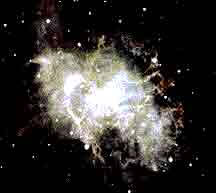|
       
> Star Formation
> Life and Death of a star
> Physical Description
> Star Catalogues
> Classification of Stellar Spectra
> Double Stars
> Variable Stars
> Neutron Star
> Black Holes
    
|
All stars probably vary
slightly in their brightness on a more or less periodic basis, including
the Sun. Such variations may be scarcely measurable. Some stars, however,
change greatly in brightness and are called variable stars. There are many
types. Some repeat cycles with almost clock-like precision; others are
highly irregular. Some may require only hours or days to return to a given
brightness; others may require years. The brightness of such stars may
change almost imperceptibly or violently.
The most spectacular variables are the novae and supernovae. Novae may
brighten to as much as 200,000 times the Sun's brightness by blowing off
perhaps a hundredth or a thousandth of 1 per cent of the Sun's mass at
speeds up to 960 km/s (600 mi/s). Some novae repeat this process
periodically until they lose too much mass to continue.
Although supernovae are similarly named, they are a far more catastrophic
phenomenon and not periodic at all. They represent the true explosion of a
star, sometimes brightening for a few days to 10 billion times the Sun's
true brightness before fading away permanently. They leave behind
expanding wreckage seen as bright gaseous clouds, or nebulae; the Crab
Nebula is an example, first observed from the Earth as a supernova in
1054. Sometimes a pulsar is also left as a remnant at the centre of the
wreckage. Novae occur fairly frequently in the Milky Way, perhaps one or
two being observed each year, but supernovae are much rarer. The most
recent supernova in the Milky Way appeared in 1604, although one in a
nearby galaxy drew great attention in 1987.
Many variable stars change their brightness because they pulsate, that is,
expand and contract somewhat like a balloon. One important type, named
Cepheid variables after δ Cephei, repeat their brightness cycles rather
accurately. Their periods range from about a day to hundreds of days, and
they are all hundreds of times more luminous than the Sun. The longer the
period of a Cepheid variable, the greater the average brightness of the
star. This period-luminosity relation, discovered by Henrietta Leavitt of
the Harvard College Observatory, has proved invaluable in measuring
stellar distances, particularly to nearby galaxies. Only the period and
average apparent brightness of a Cepheid need be observed to provide a
measure of its distance. Novae and especially supernovae are also
important distance measures because their incredible brilliance at maximum
light makes them observable at huge distances.
 |
Crab Nebula
An exploding supernova leaves behind
a rapidly expanding cloud of gaseous material called a nebula. The
Crab Nebula was produced when a star in our galaxy exploded; the
light from the explosion was observed by Chinese astronomers in
1054. At the centre of the Nebula lies a pulsar, a dense, rapidly
spinning star. |
Variable stars are of unusual interest because their variation is usually
caused by some peculiarity of their internal structure that develops with
age. Variable stars can thus reveal information about stellar evolution.
Supernovae, for example, have burned up their nuclear fuel and must blow
off matter because they become unstable as they collapse gravitationally.
The eclipsing variable, mentioned in the previous section, varies because
of external rather than internal causes. The star Algol in the
constellation Perseus is typical. Algol is a double star composed of one
bright and one comparatively faint component, orbiting each other in a
plane almost exactly in the line of sight from the Earth. As the darker
component eclipses the brighter, the apparent brightness of the pair falls
off sharply, and a similar but less marked diminution occurs when the
brighter component eclipses the darker. Astronomers have observed many
thousands of eclipsing variable stars, which are valuable in measuring
stellar masses.
[Back] [Top] [Next] |
